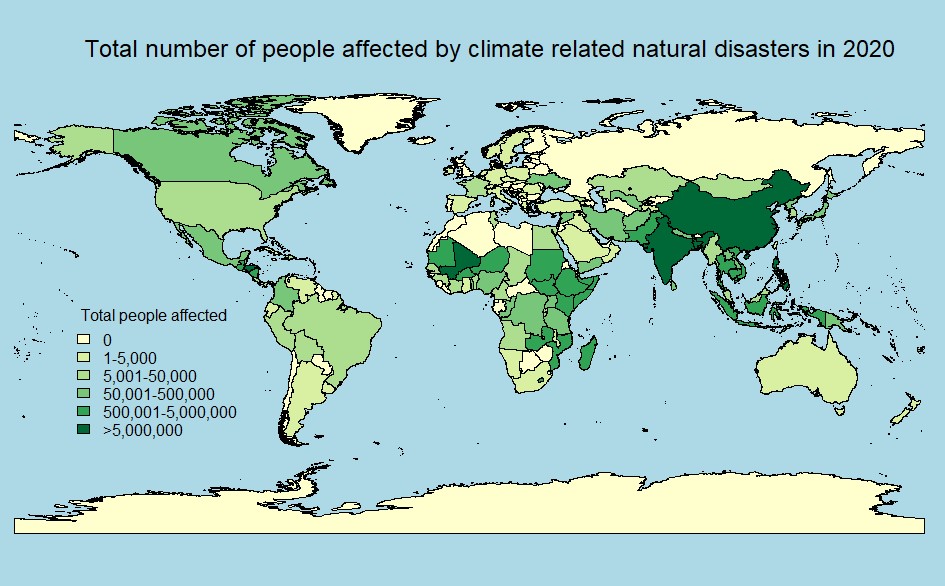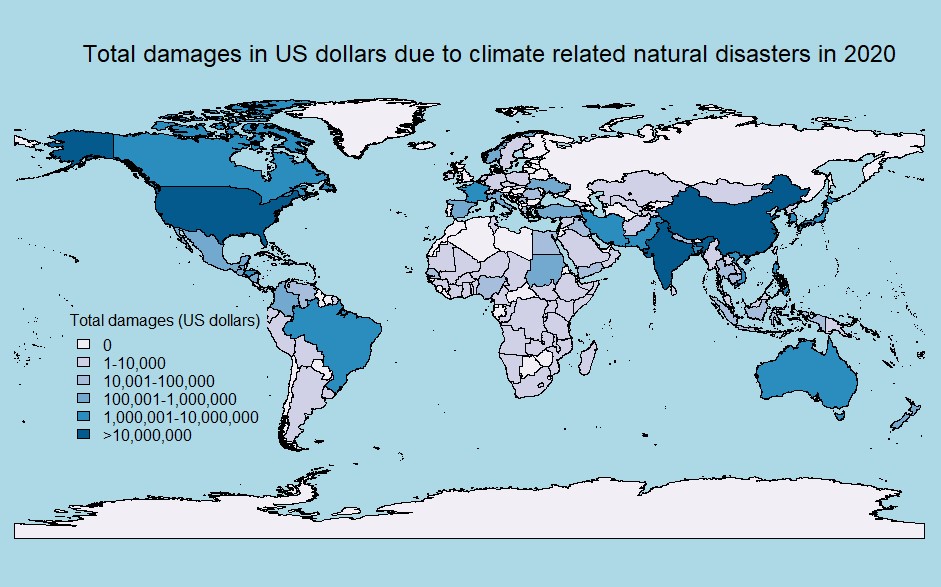Maps 4 & 5: Global climate related natural disasters | 7th Nov 2021
Claire Dooley
#30DayMapChallenge themes: green & blue
Data
- EM-DAT, CRED / UCLouvain, Brussels, Belgium – www.emdat.be (D. Guha-Sapir)
- Natural Earth Admin 0 boundaries (Natural Earth, 2021; https://www.naturalearthdata.com/downloads/10m-cultural-vectors/10m-admin-0-details/)
Code
Map code available on GitHub.
I used the sf (Pebesma, 2018) and data.tables (Dowle et al., 2021) packages to convert data into an easy-to-use format, and the RColorBrewer package for the colour palette (Neuwirth, 2014).
About the maps
Climate related natural disasters are those caused by powerful storms or extremes in temperature or precipitation. These events are usually categorised as meteorological, hydrological or climatological, and don’t include geophysical natural disasters such as earthquakes and volcanic activity. Natural disasters cause loss of life, injury, displacement, property damage and economic disruption, and mounting evidence points to an increase in disasters relating to climate as global warming continues (Adger & Brooks, 2003; Swain et al., 2020). The maps below show the total number of people affected by climate related natural disasters, and associated damages (in US dollars) across the globe in 2020 (EM-DAT, CRED / UCLouvain, Brussels, Belgium). As you can see, the impact of climate events are wide spread and, under current climate projections, the situation is likely to worsen over the coming years.

The map above displays the reported number of people in need of assistance because of injury, lack of food, water, etc., or lack of shelter, caused by climate related natural disasters. Gathering estimates such as those shown is no easy task! There are often discrepancies in definitions of the ‘people affected’ across reports and other sources and collecting data in an often chaotic aftermath of a natural disaster can both lead to inconsistencies in data collection and impact the accuracy of numbers.
One excellent data source, specifically relating to displacement estimates, is the Internal Displacement Monitoring Centre (IDMC). By integrating field collecting data, data analyses and external reporting systems, IDMC produces estimates and predictions of displacement due the disasters as well as conflict.

The map above shows the reported total damages in US dollars due to climate related natural disasters. The direct economic impact due to damages is huge, but it is likely that the long-term financial burden is even greater. Damage to crops, reduced food production, restricted access to safe water and disruption to livelihoods can all have long lasting effects. Scrutiny of ongoing efforts to curb global warming have been dominating recent news with the current UN Climate Change Conference (#COP26). While the emphasis of COP26 has been on cutting greenhouse gas emissions, the humanitarian sector are expressing concern over the lack of attention on those currently suffering from climate related events and the lack of committed funds urgently needed. For an account of existing climate crisis needs see this recent article in The New Humanitarian.
The last several decades have seen an increasing number of research and evidence-gathering programmes on climate mitigation and adaptation. One fantastic tool that collates evidence of nature-based solutions to climate change impacts is the Evidence Platform produced by the NBS initiative (University of Oxford). Combining evidence with policy development is crucial for protecting and supporting the ever-growing global population impacted by climate change, but this must be met with political will if we are going to reduce both acute and chronic needs.
Citations
- EM-DAT, CRED / UCLouvain, Brussels, Belgium – www.emdat.be (D. Guha-Sapir). Downloaded data for Natural Disasters for all countries for 2020 & 2021 on 06/11/2021
- Natural Earth. (2021). “Admin 0 boundaries ‘map unit’ boundaries”. https://www.naturalearthdata.com/downloads/10m-cultural-vectors/10m-admin-0-details/. Downloaded data on 06/11/2021
- Pebesma, E. (2018). “Simple Features for R: Standardized Support for Spatial Vector Data.” The R Journal, 10(1), 439–446. doi: 10.32614/RJ-2018-009
- Dowle, M., et al. (2021) “ data.table: Extension of ‘data.frame’ ” https://r-datatable.com, https://Rdatatable.gitlab.io/data.table, https://github.com/Rdatatable/data.table
- Neuwirth, E. (2014). “RColorBrewer: ColorBrewer Palettes. R package version 1.1-2” https://CRAN.R-project.org/package=RColorBrewer
- Adger, W.N., & Brooks, N. (2003). “Does global environmental change cause vulnerability to disaster?” In M. Pelling (Ed.), Natural Disasters and Development in a Globalising World (pp. 19-42). Routledge.
- Swain, D.L., Singh, D., Touma, D., Diffenbaugh, N.S. (2020). “Attributing Extreme Events to Climate Change: A New Frontier in a Warming World”. One Earth. 2, 522-527. https://doi.org/10.1016/j.oneear.2020.05.011
License: CC BY
Back to main

